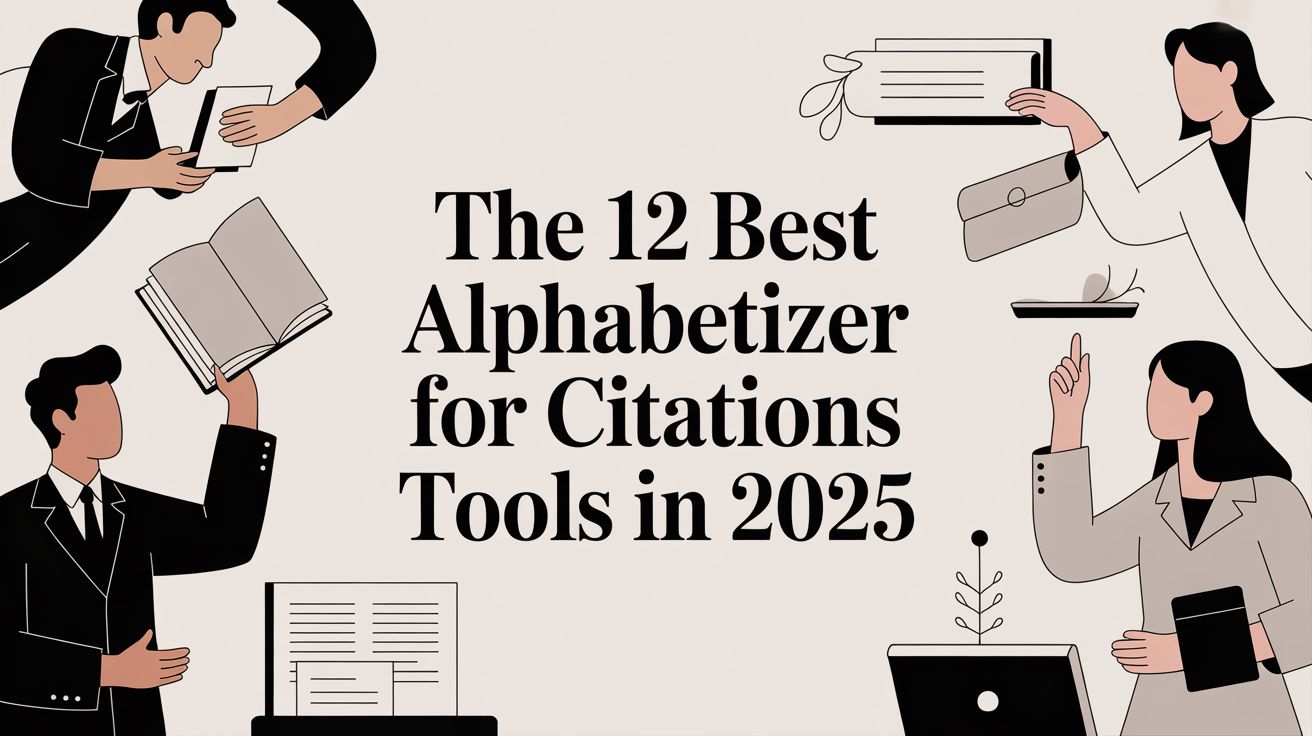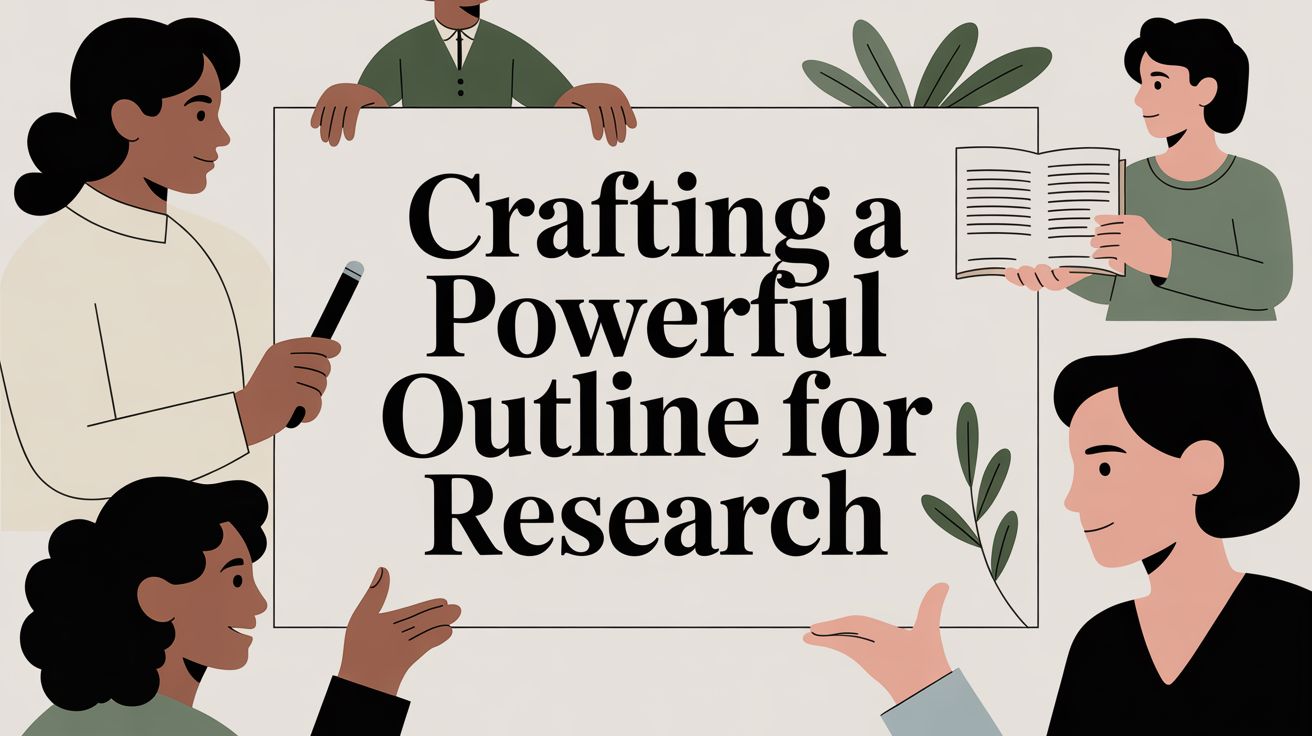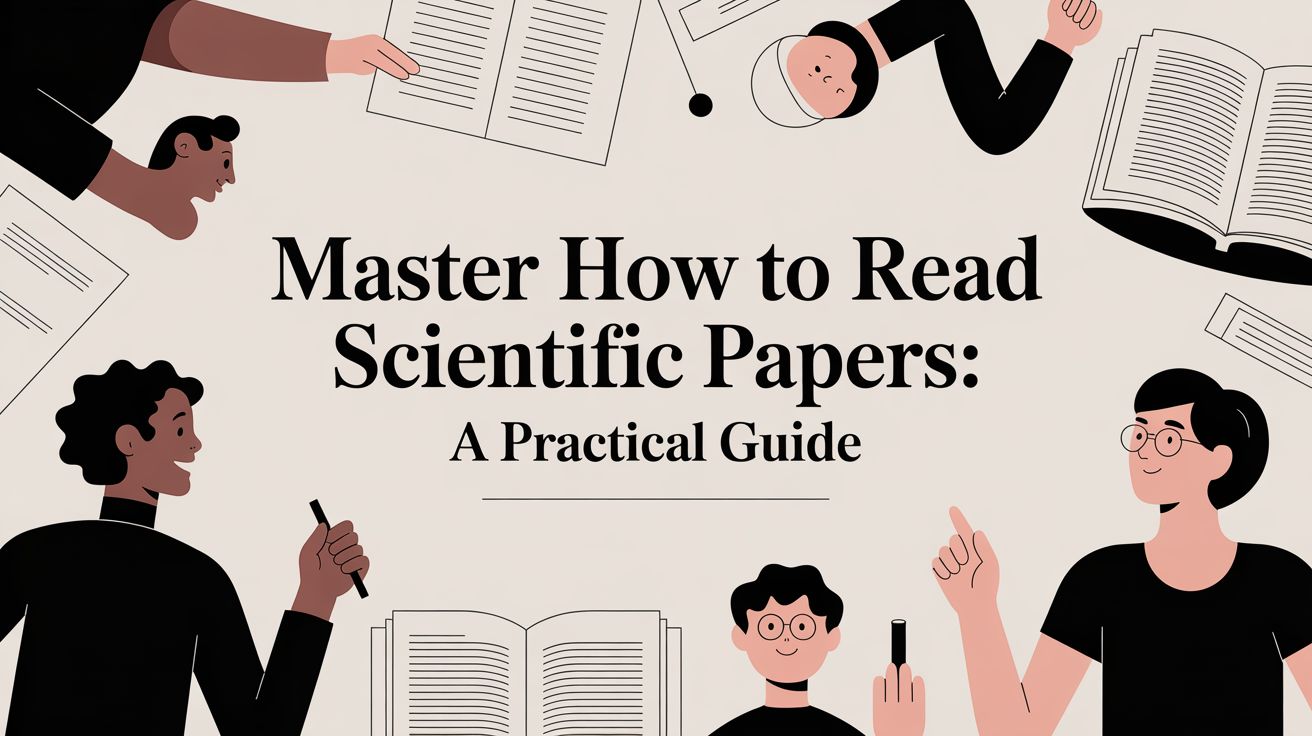12 Best AI Tools for Academic Research in 2025
Discover the best AI tools for academic research. Our curated list covers literature reviews, data extraction, writing, and summarization to speed up your work.
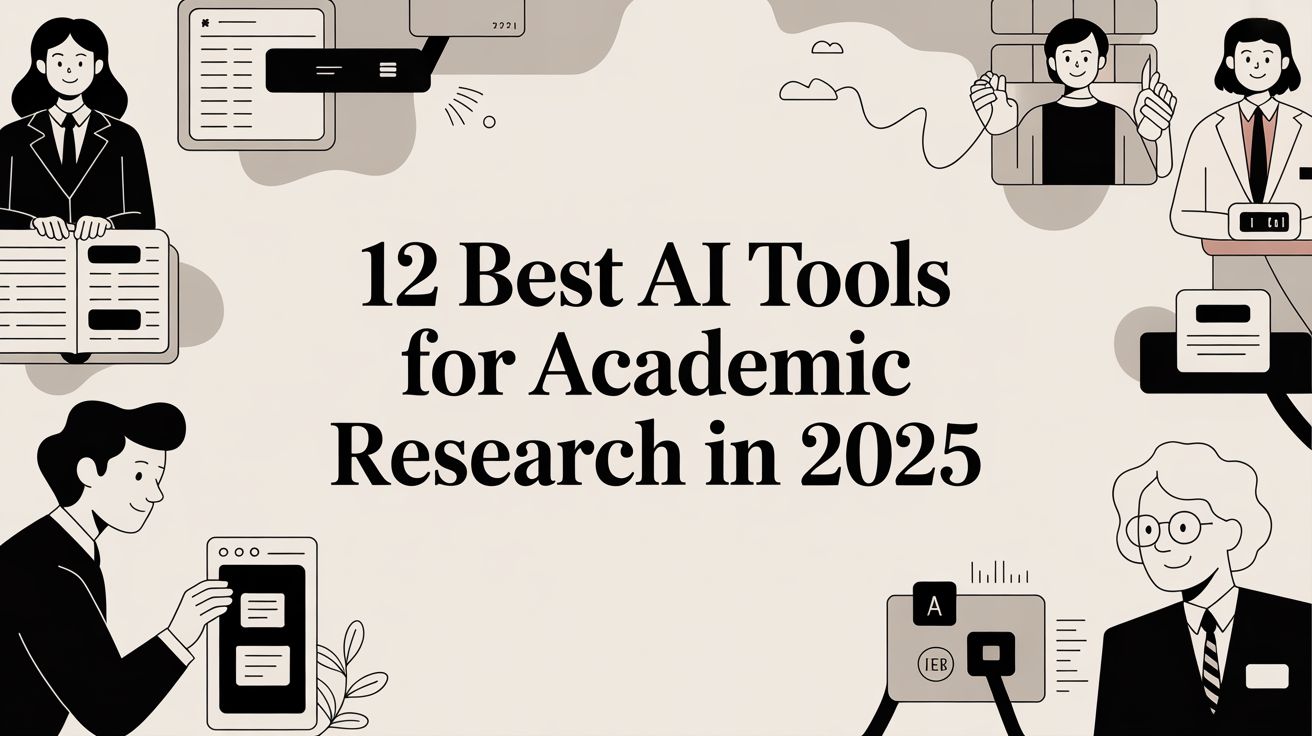
The academic world is undergoing a significant transformation, driven by artificial intelligence. From deciphering dense papers to synthesizing vast literature reviews, AI tools are no longer just a novelty; they are essential for modern researchers. The challenge isn't finding a tool, but finding the right one that fits your specific workflow, accelerates your process, and enhances the quality of your output.
Whether you're a PhD student navigating your first literature review, a seasoned academic managing multiple projects, or a professional analyzing complex reports, the pressure to produce high-quality work efficiently is immense. This guide cuts through the noise. We've meticulously evaluated the top platforms to bring you a definitive list of the best AI tools for academic research. For researchers dealing with extensive qualitative data from interviews, focus groups, and lectures, specialized academic transcription services, often leveraging AI, are invaluable for transforming spoken word into searchable text.
Inside this comprehensive roundup, you will discover tools that specialize in:
- Literature Discovery & Synthesis: Uncovering relevant papers and summarizing key findings.
- Data Extraction & Analysis: Pulling specific data points and identifying trends.
- Citation & Reference Management: Tracking sources and ensuring accuracy.
- Academic Writing & Polishing: Improving clarity, structure, and grammar.
We'll explore the unique strengths, practical use cases, pricing, and honest limitations of each tool, complete with screenshots and direct links. Our goal is to help you build a powerful, efficient research toolkit that saves you hundreds of hours and elevates your work. Let's dive in.
1. PDF Summarizer
PDF Summarizer stands out as an exceptionally powerful and user-centric platform, solidifying its position as one of the best AI tools for academic research. It excels at transforming dense, complex PDFs into digestible summaries and interactive conversations. The tool is engineered specifically for the rigors of academic work, enabling researchers and students to rapidly extract core insights from journal articles, literature reviews, and technical reports without getting lost in the details.
Its core strength lies in its ability to provide answers with clickable, verifiable citations. When you ask a question about a document, the AI doesn't just give you an answer; it points you directly to the exact passage in the original PDF where the information was found. This feature is a game-changer for maintaining academic integrity, allowing for instant source verification and a deeper understanding of the context, effectively bridging the gap between AI-driven summary and critical human analysis.
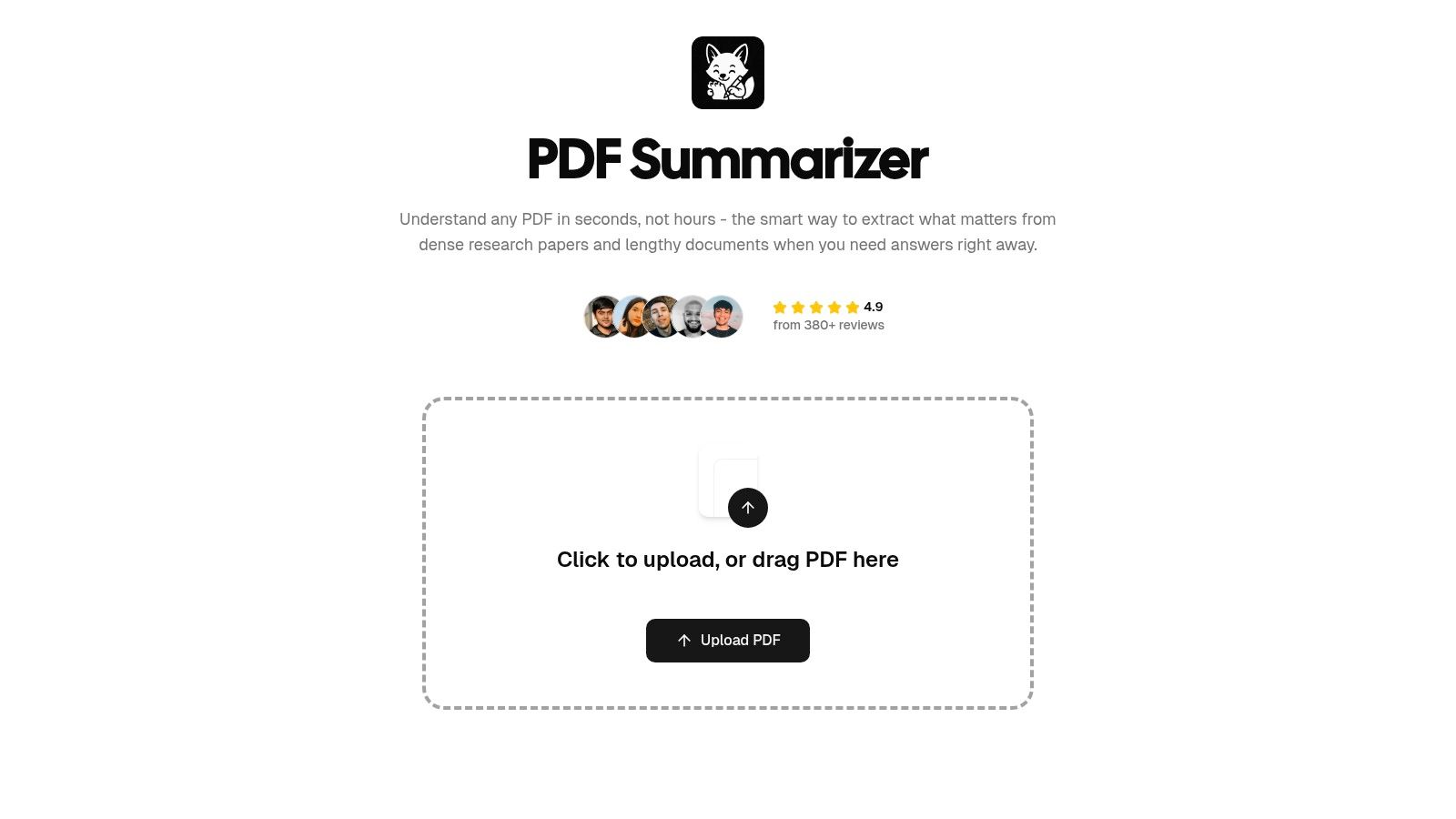
Key Features & Academic Use-Cases
- Multi-File Chat for Literature Reviews: The standout Multi-File Chat feature allows you to upload multiple PDFs into a single, unified conversation. You can ask complex questions across your entire source list, such as "Compare the methodologies used in these three papers" or "Summarize the key findings related to protein synthesis from all uploaded documents." This capability streamlines the literature review process, making it far more efficient to identify themes, gaps, and connections across various studies.
- Instant, Source-Linked Answers: Every answer generated by the AI includes a clickable citation that navigates you to the precise location in the source PDF. This is invaluable for fact-checking, quoting, and building a properly-cited bibliography.
- Full Multilingual Support: The platform supports on-the-fly translation. You can upload a paper in German, ask questions in English, and receive answers in English with citations linked back to the original German text, breaking down language barriers in global research.
Pros & Cons
| Pros | Cons |
|---|---|
| Instant, verifiable citations that link directly to the source text. | Relies on an internet connection; no offline functionality is available. |
| Multi-File Chat is a superior tool for synthesizing information across multiple documents. | AI-generated answers, while cited, may still require human verification for highly nuanced interpretations. |
| No sign-up required to try and a generous free tier make it highly accessible. | |
| Strong security protocols, including SOC2 Type II certification and document encryption. |
Pricing & Availability
PDF Summarizer is a browser-based tool accessible on any device at pdfsummarizer.pro. It operates on a freemium model, allowing users to start for free without an account. For more intensive research needs, paid plans are available to accommodate a higher volume of documents and questions.
2. Elicit
Elicit positions itself as a dedicated AI research assistant, excelling at structured, end-to-end literature review workflows. It moves beyond simple summarization by allowing researchers to ask a question and receive a summary of top findings from relevant papers, complete with direct citations. This makes it one of the best AI tools for academic research, particularly for those undertaking systematic reviews or meta-analyses.
The platform's core strength lies in its ability to automate the laborious parts of a literature review. Users can discover relevant papers, screen large volumes of abstracts, and extract specific data points into structured tables. Elicit’s interface is designed for researchers, enabling workflows like finding papers that use a specific methodology or extracting population characteristics from multiple studies simultaneously.

Key Features & Use Cases
- Systematic Literature Reviews: Elicit’s "Find Papers" workflow identifies relevant articles based on a research question. You can then add custom columns to extract specific details (e.g., sample size, intervention type) from each paper, creating a comprehensive data matrix for analysis.
- Source-Backed Summaries: Unlike generic chatbots, Elicit provides answers grounded in academic sources, linking every claim back to the original paper for verification. This transparent approach is critical for maintaining academic integrity.
- Bulk PDF Analysis: Users can upload a library of papers (up to 100 at a time on paid plans) and ask questions across the entire set, making it invaluable for synthesizing findings from a curated collection.
Pro Tip: Combine Elicit’s discovery features with a tool like PDF Summarizer. Use Elicit to identify and screen the most relevant papers, then upload those key PDFs to PDF Summarizer for a deeper, more detailed individual analysis and chat-based Q&A. This two-step process streamlines both the macro and micro levels of your research. If you need to refine your approach, you can learn more about how to conduct a literature review with these new tools.
Pros, Cons, and Pricing
| Aspect | Details |
|---|---|
| Pros | Strong focus on systematic-review workflows. Transparent citations and explanations for AI answers. Generous free tier for exploration. |
| Cons | Extraction quotas scale by plan, potentially limiting large projects on lower tiers. Advanced team features and higher upload limits require pricier subscriptions. |
| Pricing | Free Basic Plan: Offers 5,000 one-time credits. Plus Plan: $10/month (billed annually) for 12,000 monthly credits. Enterprise & Institutions: Custom pricing. |
| Integrations | Zotero import for seamless library integration. Export options include RIS, CSV, and BIB for compatibility with most reference managers. |
Website: https://elicit.com
3. Perplexity
Perplexity AI operates as a conversational "answer engine," distinguishing itself from traditional search engines by providing direct, synthesized answers complete with citations. Its "Academic" focus mode specifically searches scholarly sources like journals and institutional repositories, making it a powerful tool for initial research scoping and finding foundational papers. This citation-first approach helps bridge the gap between quick queries and academic rigor.
The platform excels at providing rapid, source-backed overviews of complex topics. Instead of just a list of links, Perplexity delivers a concise summary paragraph with numbered, in-line citations that link directly to the source material. This makes it one of the best AI tools for academic research when you need to quickly get up to speed on a new subject, verify a specific fact, or identify key authors in a field without committing to a full-scale literature review.
Key Features & Use Cases
- Focused Academic Search: Use the "Academic" focus setting to ensure your answers are drawn from scholarly databases, pre-print archives like arXiv, and academic journals. This is ideal for preliminary literature exploration.
- File Analysis and Q&A: The Pro version allows users to upload documents (including PDFs) and ask questions directly about their content, functioning as an effective tool for analyzing individual papers or reports.
- Threaded Follow-up Questions: Perplexity maintains the context of your conversation, allowing you to ask follow-up questions to dig deeper into a topic, refine your query, or ask for clarification without starting over.
Pro Tip: Use Perplexity for the initial discovery phase of your research. Ask broad questions to map out a topic and identify key papers. Once you have a shortlist of highly relevant articles, upload them to PDF Summarizer to conduct a more in-depth, chat-based analysis of each document's specific methodology and findings.
Pros, Cons, and Pricing
| Aspect | Details |
|---|---|
| Pros | Fast, citation-rich answers are excellent for initial topic scoping. A generous Education Pro discount is available for verified students and faculty. Clear, live web citations build trust. |
| Cons | Free searches are limited, and Pro is needed for file uploads and advanced AI model access. Deep research requiring extensive API usage has separate token pricing to consider. |
| Pricing | Free Plan: Limited number of Pro searches. Pro Plan: $20/month for access to top models (GPT-4, Claude 3), unlimited file uploads, and more. Enterprise: Custom pricing. |
| Integrations | No direct reference manager integrations, but citations can be manually exported or copied. |
Website: https://www.perplexity.ai
4. Consensus
Consensus operates as a specialized AI search engine for research, designed to extract and synthesize direct findings from over 200 million academic papers. Instead of just listing papers, it provides evidence-backed answers to natural language questions, displaying key findings and study details in a digestible format. This makes it an invaluable tool for researchers needing quick, reliable answers grounded in scientific literature.
The platform excels at evidence synthesis. When you ask a question, Consensus scans its vast database and presents "Study Snapshots" that summarize the population, intervention, and outcomes of relevant studies. This allows for rapid assessment of research quality and relevance without needing to read every abstract, establishing it as one of the best AI tools for academic research when building an evidence base.

Key Features & Use Cases
- Evidence-Based Answers: Ask questions like "What is the effect of mindfulness on anxiety?" and receive a synthesized list of findings directly from published research, complete with citations and study quality indicators.
- Deep Search & Pro Analyses: Premium features allow for more complex queries and AI-powered analyses like creating summary paragraphs, lists of findings, or even meta-analysis-style tables directly from search results.
- PDF Analysis with "Ask Paper": Similar to other chat-with-PDF tools, users can upload a paper and use an AI assistant to ask specific questions about its methodology, results, or conclusions, streamlining individual paper review.
Pro Tip: Use Consensus to quickly validate a research hypothesis or find supporting evidence for a claim. Its ability to show whether findings are from rigorous studies (e.g., randomized controlled trials) helps you prioritize which papers to analyze more deeply. Once you've identified key papers, you can upload them to a tool like PDF Summarizer to conduct a more granular, conversational analysis of their contents.
Pros, Cons, and Pricing
| Aspect | Details |
|---|---|
| Pros | Highly focused on academic results and evidence synthesis. Study snapshots provide quick insights into research quality. The Pro plan offers advanced analytical features at an accessible price point. |
| Cons | Advanced features like Deep Search are limited by quotas based on the subscription tier. Pricing information is primarily located in its help center rather than on a dedicated, easily accessible pricing page. |
| Pricing | Free Plan: Available with limited searches and features. Premium Plan: $11.99/month (billed monthly) for unlimited searches, 2,000 AI credits, and access to premium features like Synthesis and Study Snapshot. |
| Integrations | Primarily a standalone search engine, but results can be exported in formats like BIB, CSV, or RIS for use with reference managers such as Zotero, Mendeley, and EndNote. |
Website: https://consensus.app
5. scite
scite introduces a critical layer of context to academic citations, transforming how researchers evaluate the credibility and impact of scientific literature. Instead of just counting citations, scite's "Smart Citations" classify how a paper is cited, indicating whether the reference supports, mentions, or contrasts the cited claim. This unique approach makes it one of the best AI tools for academic research for anyone needing to quickly assess the scientific consensus around a topic.
The platform moves beyond simple discovery by providing a nuanced view of a paper's reception within its field. With over 1.3 billion citation statements indexed, researchers can instantly see the conversational context of a study. This is invaluable for identifying foundational papers, uncovering academic debates, and ensuring your own arguments are built on well-supported evidence.
Key Features & Use Cases
- Smart Citations: Instantly see if a citation provides supporting or contrasting evidence for a claim, helping you quickly gauge a paper’s scientific standing and avoid relying on retracted or disputed findings.
- Literature Mapping: Use citation reports to visualize how a paper has been received over time. This is perfect for understanding the trajectory of a research topic or identifying key critiques of a specific study.
- AI Research Assistant: Ask research questions and receive answers synthesized from top-cited, relevant articles, with the context of Smart Citations integrated directly into the results for enhanced reliability.
Pro Tip: Use scite to verify the core arguments of the papers you discover. Once you identify a highly supported article, use a tool like PDF Summarizer to deeply engage with its content. This combination ensures you are working with credible sources and fully understanding the nuances of their arguments, which is essential when learning how to effectively read scientific papers.
Pros, Cons, and Pricing
| Aspect | Details |
|---|---|
| Pros | Unique contextual citations (support/contrast). Excellent for credibility checks and mapping academic conversations. Robust dashboard and alert features for staying current on research topics. |
| Cons | Pricing details for personal plans can be less transparent, often fully revealed at checkout. Advanced analytics and export options are primarily available on more expensive Organization plans. |
| Pricing | Limited Free Access: Basic searching and viewing of Smart Citation counts. Premium Plan: $16/month (billed annually) for full access to reports and assistant features. Organizations Plan: Custom pricing for institutions. |
| Integrations | Browser extensions for Chrome, Firefox, and Zotero to see Smart Citations wherever you read papers. Export options include CSV and RIS. |
Website: https://scite.ai
6. SciSpace
SciSpace positions itself as a comprehensive, end-to-end platform for the entire research lifecycle, from reading and understanding to writing and publishing. It integrates multiple AI-powered functionalities, including a powerful "Copilot" for interacting with documents, literature review tools, and an AI writer, making it a versatile choice among the best AI tools for academic research. Its goal is to provide a single, unified workspace to minimize tool-switching and streamline complex academic tasks.
The platform's standout feature is its breadth, offering everything from a "Chat with PDF" function for deep-diving into individual papers to an AI paraphraser for refining academic writing. SciSpace’s Copilot can explain complex tables, charts, and mathematical equations within a paper, a feature that distinguishes it from more basic summarizers. This multi-faceted approach supports researchers through discovery, analysis, and composition.
Key Features & Use Cases
- All-in-One Research Suite: SciSpace combines a literature review database with a PDF analyzer, AI writer, and paraphrasing tool. This allows users to find papers, ask detailed questions about their content, and then draft manuscript sections within the same environment.
- Deep Document Analysis: The Copilot feature goes beyond simple Q&A. You can ask it to explain the methodology of a study, summarize its key findings, or clarify the data presented in a specific table or figure, receiving context-aware answers.
- Automated Workflow Agents: Users can leverage pre-built "Agents" to automate multi-step research tasks, such as conducting a systematic literature review (SLR) step-by-step or extracting specific types of data from a collection of papers.
Pros, Cons, and Pricing
| Aspect | Details |
|---|---|
| Pros | Broad feature set covering reading, writing, and data extraction. Agents offer powerful workflow automation. Team and enterprise tiers provide administrative controls for institutional use. |
| Cons | The credit-based system can be confusing for new users. Pricing details and credit quotas can change, so it's best to verify them directly on their site. |
| Pricing | Free Basic Plan: Includes limited features and credits. Premium Plan: $12/month (billed annually) for more credits, unlimited PDF uploads, and Copilot answers. Teams Plan: $19/user/month (billed annually) adds collaboration features and admin tools. |
| Integrations | Exports available in RIS, CSV, BIB, Excel, and XML formats on paid plans, ensuring compatibility with reference managers like Zotero, Mendeley, and EndNote. |
Website: https://scispace.com
7. Semantic Scholar
Semantic Scholar, developed by the Allen Institute for AI, is a free, AI-powered research tool that accelerates the literature discovery process. Its standout feature is the AI-generated TLDR (Too Long; Didn't Read), a one-sentence summary that appears for millions of papers directly in the search results. This makes it one of the best AI tools for academic research when performing a rapid initial screening to determine a paper's relevance.
The platform streamlines the often-overwhelming task of sifting through dozens of abstracts. Instead of reading each one fully, researchers can quickly scan the concise TLDRs to triage papers, saving significant time during the first pass of a literature review. It covers a vast range of disciplines, with strong indexing in computer science and biomedicine, making it a powerful alternative to traditional academic search engines.
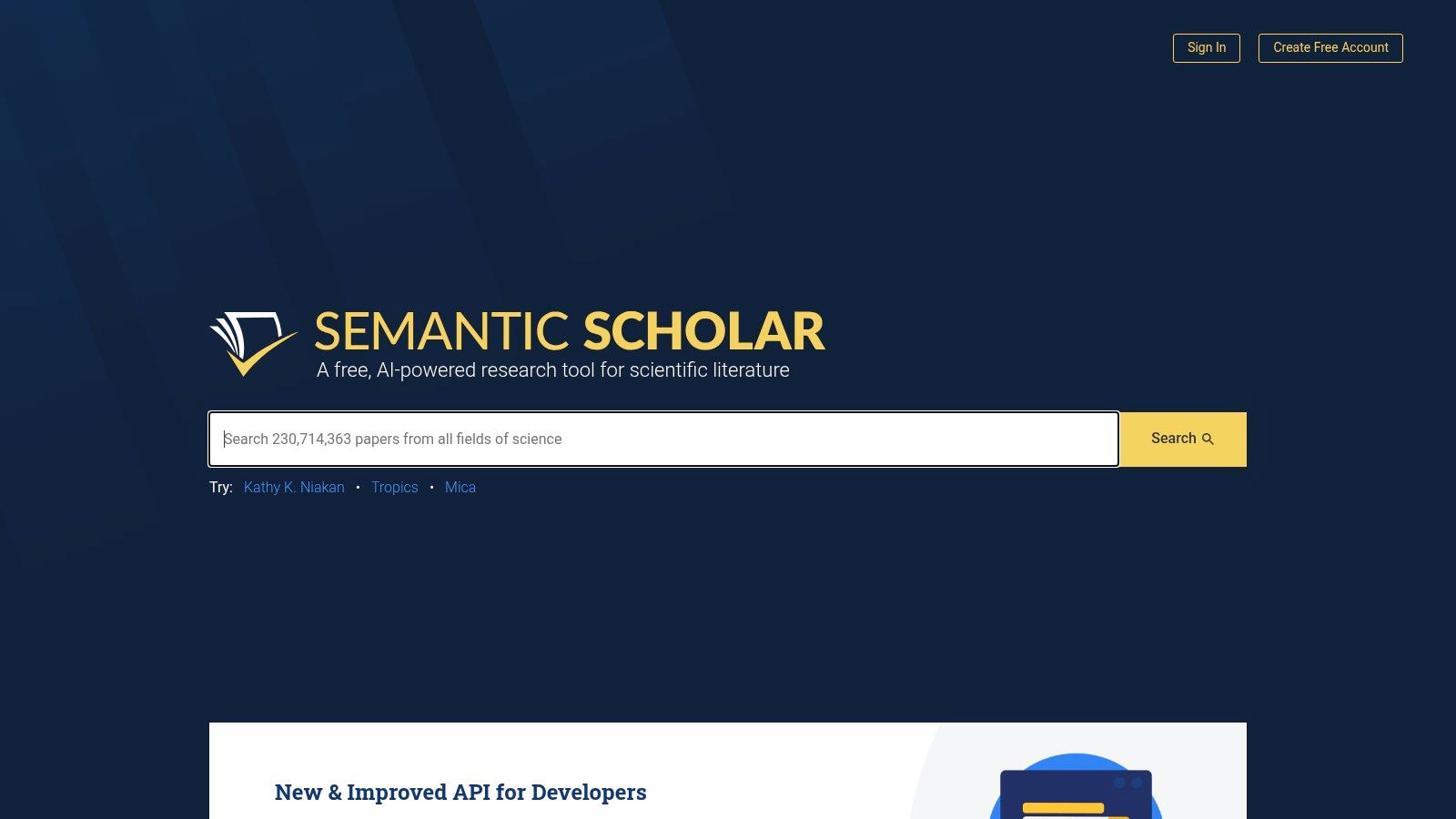
Key Features & Use Cases
- Rapid Literature Triage: Use the AI-generated TLDRs to quickly assess the relevance of numerous papers without needing to click into each one, dramatically speeding up the initial discovery phase.
- Targeted Search: Filter results by date, author, publication type, and field of study to narrow down the most pertinent literature for your specific research question.
- API for Custom Workflows: Advanced users can leverage the Semantic Scholar API to programmatically access paper data and TLDRs, enabling custom tool development or integration with other research software.
Pro Tip: Use Semantic Scholar for your initial broad search to build a long list of potentially relevant papers. Export the citations for promising articles to your reference manager, then upload the PDFs of the top contenders to a tool like PDF Summarizer for a deeper, interactive analysis and to extract specific details without reading the full texts.
Pros, Cons, and Pricing
| Aspect | Details |
|---|---|
| Pros | Completely free to use. AI-generated TLDRs significantly accelerate relevance assessment. Reputable backing from the Allen Institute for AI. APIs allow for custom integrations. |
| Cons | Lacks the structured, end-to-end workflow tools for systematic reviews found in platforms like Elicit. Its primary strength is in discovery, not deep analysis or data extraction. |
| Pricing | Completely Free: All features, including API access, are available at no cost to the research community. |
| Integrations | Offers APIs for custom development. Supports standard citation export formats (e.g., BibTeX, RIS) for compatibility with Zotero, Mendeley, and other reference managers. |
Website: https://www.semanticscholar.org
8. Litmaps
Litmaps offers a powerful visual approach to literature discovery, setting it apart as one of the best AI tools for academic research focused on exploring connections between papers. Instead of just listing articles, it generates interactive citation maps, allowing you to see how research evolves by visualizing papers that cite a source (forward) and papers a source has cited (backward). This visual network helps you quickly identify seminal works and uncover related research you might have missed.
The platform is particularly effective for scoping a new topic or teaching students how to conduct a literature search. By starting with a single key paper, you can expand outward, creating a "lit map" that reveals the broader academic conversation. The ability to set up automated alerts ensures your literature review stays current as new, relevant papers are published.
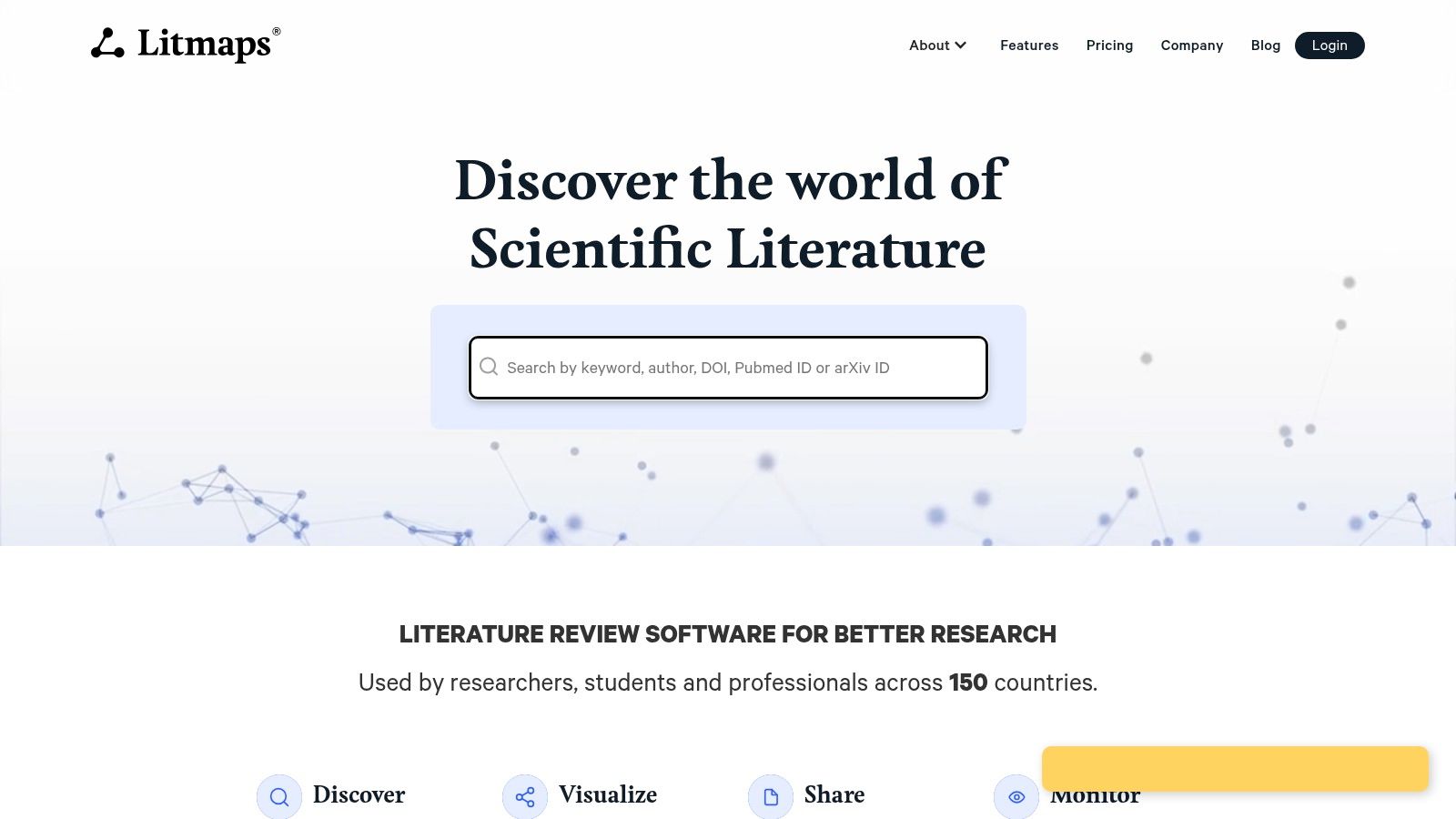
Key Features & Use Cases
- Visual Citation Mapping: Start with one or more seed papers to generate a dynamic graph of forward and backward citations. This is ideal for understanding a field's intellectual history and discovering influential articles.
- Automated Literature Monitoring: Create a map based on your research interests and set up daily or weekly alerts. Litmaps will automatically notify you of new publications that connect to your existing map, keeping your research up-to-date.
- Comprehensive Search: Paid tiers allow you to use unlimited seed papers and keywords to build more complex and exhaustive maps, ensuring no relevant article is overlooked during the discovery phase.
Pro Tip: Use Litmaps to build a foundational understanding and discover a core set of 10-20 highly relevant papers for your topic. Export this curated list as a BIB or RIS file and then upload the PDFs to a tool like PDF Summarizer to perform a deep, chat-based analysis and synthesis of the key findings across your selected literature.
Pros, Cons, and Pricing
| Aspect | Details |
|---|---|
| Pros | Highly intuitive visualization for scoping topics and teaching research methods. Affordable education pricing and country discounts make it accessible. Automated alerts are excellent for ongoing projects. |
| Cons | The free tier is quite limited in the number of articles and maps you can generate. Accessing advanced team features requires contacting sales for a custom quote. |
| Pricing | Free Plan: Limited maps and 20 articles per map. Litmaps Pro: $10/month (billed annually) with education/country discounts available. Teams: Custom pricing. |
| Integrations | Exports maps and article lists as CSV, RIS, or BibTeX files, making it compatible with Zotero, Mendeley, and other major reference managers. |
Website: https://www.litmaps.com
9. Connected Papers
Connected Papers is a unique visual discovery tool that helps researchers quickly understand an academic field by creating interactive graphs. Instead of listing papers, it shows you how they are connected through citations. By inputting a single "seed paper," the platform generates a dynamic graph of related articles, making it easy to spot seminal works, recent trends, and different schools of thought within a topic.
This visual approach makes it one of the best AI tools for academic research when you need to get a high-level overview of a field or explore adjacent areas. Its strength lies in its intuitive, low-friction interface that prioritizes exploration and ideation, complementing traditional keyword-based database searches with a structural, network-based perspective. The ability to see relationships at a glance is invaluable for building a comprehensive understanding quickly.

Key Features & Use Cases
- Visual Knowledge Mapping: Generate a graph from a single influential paper to find prior and derivative works. This helps identify the foundational and most recent studies in that specific research lineage.
- Multi-Origin Graphs: Combine several key papers to create a unified graph, revealing the interdisciplinary connections or overlaps between different research areas. This is perfect for synthesizing disparate fields.
- Teaching and Onboarding: The visual nature of the graphs makes it an excellent tool for introducing students or new researchers to a complex academic field, helping them grasp the key papers and their relationships without getting lost in lists.
Pro Tip: Use Connected Papers to identify a cluster of highly relevant articles. Export the BibTeX file for that cluster and import it into Zotero. Then, upload the most promising PDFs from that collection to a tool like PDF Summarizer for a deep-dive analysis and to ask specific questions about their methodologies and findings.
Pros, Cons, and Pricing
| Aspect | Details |
|---|---|
| Pros | Extremely intuitive with a very low learning curve. Excellent for ideation and teaching. Complements traditional database searches by providing a structural view of a research field. Multi-origin graphs are great for exploring overlaps. |
| Cons | Best used alongside traditional databases for complete coverage, as it is not a primary search engine. The pricing page is located within the application itself, which can be slightly inconvenient. |
| Pricing | Free Plan: Offers 5 graphs per month. Academic Plan: $7/month (billed annually) for unlimited graphs and premium features. Business: $17/month (billed annually). |
| Integrations | Integrates with Semantic Scholar for paper data and allows exporting citations to reference managers like Zotero, Mendeley, and EndNote via BibTeX and RIS formats. |
Website: https://www.connectedpapers.com
10. ResearchRabbit
ResearchRabbit bills itself as the "Spotify for Papers," using AI to help you discover relevant literature through visual, network-based exploration. Instead of just returning a list of search results, it maps out the academic landscape, showing how papers and authors are connected. This visual approach makes it one of the best AI tools for academic research, especially for understanding a new field or tracking the evolution of a research topic over time.
The platform excels at serendipitous discovery. By adding a few key "seed papers" to a collection, ResearchRabbit’s AI gets to work, suggesting new and related articles, influential authors, and earlier foundational work. This allows researchers to follow citation trails and uncover hidden gems they might miss with traditional keyword-based searches, making the literature review process more dynamic and comprehensive.
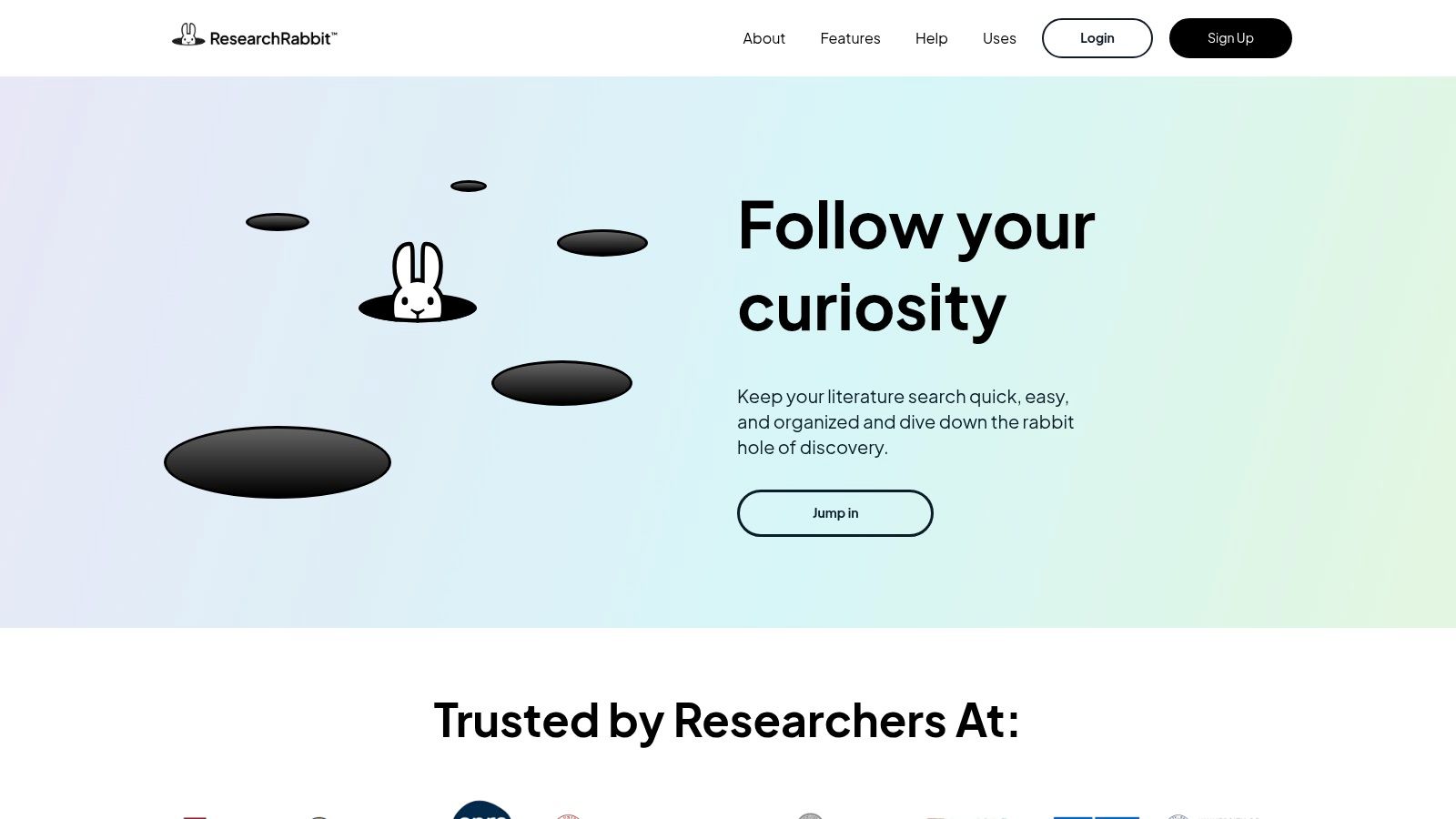
Key Features & Use Cases
- Network Visualization: Explore interactive graphs that show connections between papers and authors. This is perfect for identifying key researchers in a field or tracing the intellectual lineage of a specific concept.
- Continuous Monitoring: Create collections for your projects and set up email alerts. ResearchRabbit will continuously scan for new, relevant publications and notify you, ensuring you stay current with the latest research.
- Collaborative Collections: Share your paper collections with colleagues or research groups, making it an effective tool for collaborative literature discovery and annotation.
Pro Tip: Use ResearchRabbit for the initial discovery phase of your literature review. Once its visual network helps you identify a core set of highly relevant papers, upload those specific PDFs to a tool like PDF Summarizer for deep-dive analysis, summarization, and to ask targeted questions about their methodologies and findings.
Pros, Cons, and Pricing
| Aspect | Details |
|---|---|
| Pros | Excellent for discovery and continuous topic tracking. Clean graph visualizations make complex connections easy to understand. Generous free tier and flexible pricing with country-parity discounts. |
| Cons | Lacks the deep data extraction and systematic review features of more specialized tools. The focus is more on discovery and less on in-depth content analysis. |
| Pricing | Free Plan: Available for all users. RR+ (Premium): $8/month (billed annually) for advanced search features and higher usage limits. Institutional: Custom pricing for universities. |
| Integrations | Zotero integration for syncing collections. Export options to standard formats like BibTeX and RIS. Institutional integrations include LibKey for seamless full-text access. |
Website: https://www.researchrabbit.ai
11. Scholarcy
Scholarcy is an AI-powered article summarizer designed to break down dense research papers into manageable, structured formats. It excels at converting PDFs, Word documents, and web articles into interactive flashcards, highlighting key claims, figures, and concepts. This makes it an invaluable tool for quickly triaging large volumes of literature and for teaching evidence synthesis.
The platform's unique "Robo-Highlighter" automatically identifies important phrases and contributions, allowing researchers to grasp a paper's essence in minutes. Scholarcy builds a personal library of your analyzed articles, making them searchable and easily accessible. Its ability to create literature matrices and one-click bibliographies further solidifies its position as one of the best AI tools for academic research, especially for those in the early stages of a project.

Key Features & Use Cases
- Rapid Article Triage: Use the browser extension or upload documents to generate structured summaries, flashcards, and highlights. This is perfect for deciding which papers warrant a deeper read.
- Literature Synthesis: Automatically generate literature matrices by extracting key data points (like study participants, methods, and main findings) from multiple papers into a comparative table.
- One-Click Bibliographies: Scholarcy extracts references from any paper and can format them in popular styles, allowing you to quickly build out your bibliography as you read.
Pro Tip: Use Scholarcy's browser extension to quickly create a flashcard summary of a paper you find online. If the paper proves critical to your research, download the PDF and upload it to a chat-based tool like PDF Summarizer for an in-depth, conversational analysis where you can ask highly specific questions about its methodology and results. You can read more about how a dedicated research paper summarizer can accelerate this process.
Pros, Cons, and Pricing
| Aspect | Details |
|---|---|
| Pros | Great for rapid triage and teaching evidence synthesis. Generates structured, easy-to-digest formats like flashcards. Batch exports speed up integration into review workflows. |
| Cons | Free version has tight daily limits on usage. Institutional pricing can vary widely and requires a separate inquiry. |
| Pricing | Free Browser Extension & Flashcard Generator. Individual License: $9.99/month for unlimited articles and advanced exports. Institutional Licenses: Custom pricing for universities and organizations. |
| Integrations | Browser extensions for Chrome and Edge. Batch exports to Word, Excel, and reference managers like Zotero, Mendeley, and EndNote (on paid plans). |
Website: https://www.scholarcy.com
12. Paperpal
Paperpal is a specialized AI writing assistant designed to elevate the quality of scholarly manuscripts before submission. It moves beyond standard grammar checks by providing real-time language and style edits specifically tuned for academic prose. This focus on the nuances of scholarly writing makes it one of the best AI tools for academic research, particularly for researchers polishing their final drafts.
The platform's strength is its direct integration into the academic writing workflow. It offers plugins for Microsoft Word and Overleaf, allowing authors to receive suggestions, paraphrase complex sentences, and generate citations without leaving their document. Its pre-submission checks, including a plagiarism scan, provide a final layer of quality control, helping researchers meet the stringent standards of academic journals.
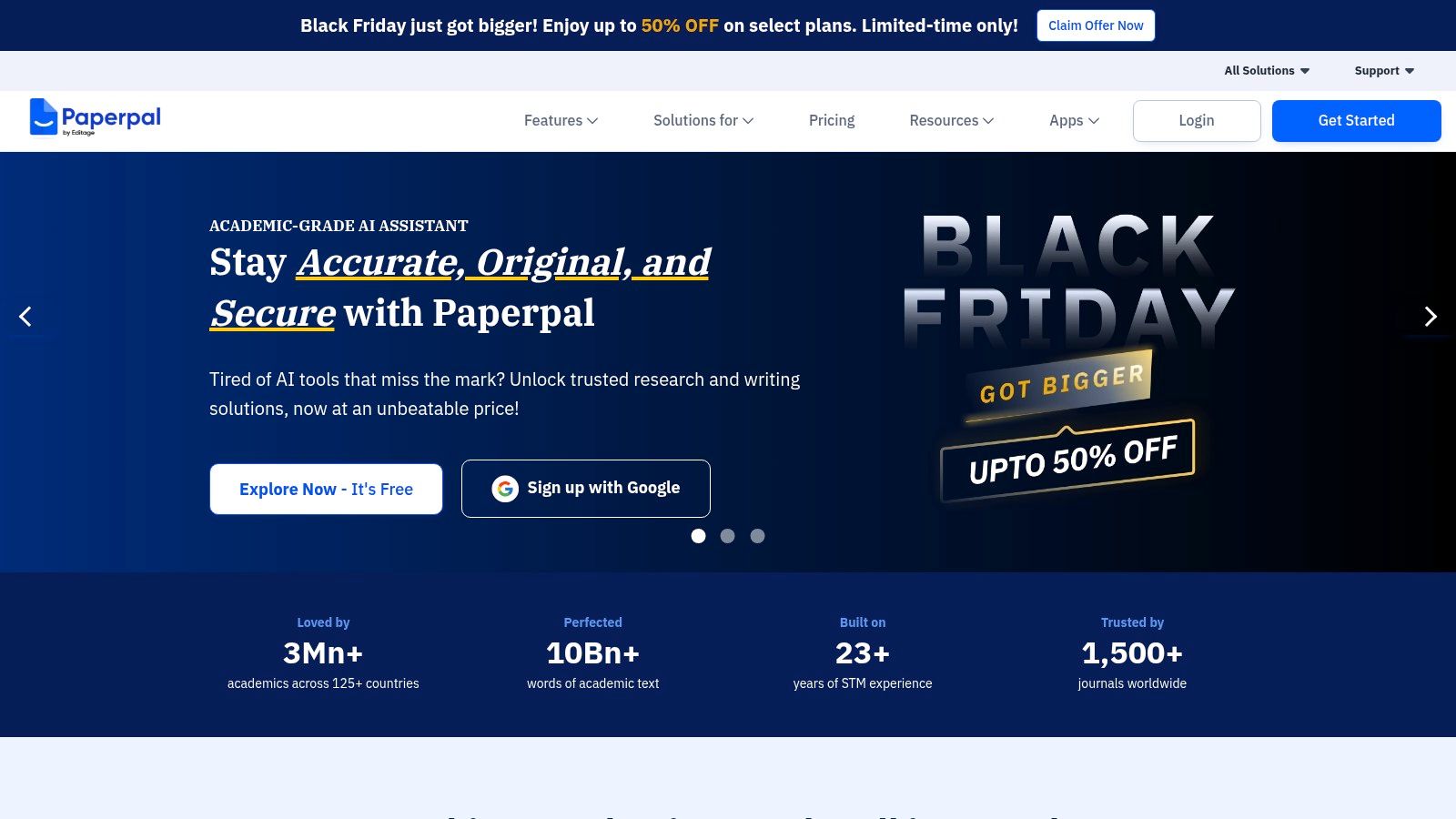
Key Features & Use Cases
- Academic-Focused Editing: Paperpal’s AI is trained on millions of published research articles, enabling it to offer discipline-appropriate suggestions for grammar, style, and vocabulary that generic tools often miss.
- Manuscript Pre-Submission Checks: Before submitting to a journal, you can run comprehensive checks for language quality, technical accuracy, and plagiarism, ensuring your manuscript is polished and ready for peer review.
- Integrated Writing Environment: With its Word and Overleaf plugins, Paperpal embeds directly into your writing process. This seamless integration allows for on-the-fly corrections, paraphrasing, and citation generation in over 10,000 styles.
Pro Tip: Use Paperpal as the final step in your writing process. After conducting your research and initial drafting with tools like Elicit or PDF Summarizer, import your manuscript into a Paperpal-enabled editor. Use its academic tone suggestions and pre-submission checks to refine your language and structure, ensuring it meets publication standards.
Pros, Cons, and Pricing
| Aspect | Details |
|---|---|
| Pros | Strong academic focus provides better edits than general grammar tools. Integrates directly with common writing platforms (Word, Overleaf). Clear Prime pricing and team discounts are available. |
| Cons | AI edits still require careful author review before submission. Some details about features and payments are spread across help documents rather than a single pricing page. |
| Pricing | Free Plan: Limited access to AI features. Prime Plan: From $99/year with monthly and student pricing options available. Enterprise & Institutions: Custom pricing. |
| Integrations | Direct integrations with Microsoft Word and Overleaf. Also available as a web editor and browser extension. |
Website: https://paperpal.com
Top 12 AI Tools for Academic Research — Features Comparison
| Tool | Core features | UX & quality | Value proposition | Best for | Price & notes |
|---|---|---|---|---|---|
| PDF Summarizer (Recommended) | AI summaries, Multi‑File Chats, side‑by‑side view, clickable citations, on‑the‑fly translation | 4.9★ (380+), browser‑based, no sign‑up, SOC2, strong encryption | Fast, source‑linked summaries and cross‑document Q&A for dense PDFs | Students, researchers, legal/compliance, multilingual users | Free to try in browser; requires internet; delete files option |
| Elicit | Literature discovery, screening, auto reports, Zotero import | Generous free tier, tiered citation transparency | End‑to‑end systematic‑review workflows | Systematic reviewers, academic researchers | Free tier; extraction quotas scale by plan; team features paid |
| Perplexity | Citation‑rich answers, Academic mode, file uploads, multiple models | Very fast answers, education discounts, enterprise controls | Quick scoping and evidence searches with live citations | Students, educators, enterprise researchers | Free/basic; Pro Search and API token pricing apply |
| Consensus | Academic search (200M+), Deep Search, Ask Paper chat, study snapshots | Evidence synthesis UI, quality indicators shown | Synthesizes literature into evidence‑backed answers | Academics performing evidence syntheses | Freemium; Deep Search/Pro analyses gated by plan |
| scite | Smart citations (support/contrast), dashboards, alerts, API | Robust indexing (1.3B+ statements), strong credibility tools | Contextualizes citations to assess claim support | Editors, reviewers, credibility checks, research mapping | Personal/org plans; advanced exports on org tier |
| SciSpace | Chat with PDF, AI Writer/paraphraser, agent automations, exports | Broad feature set, team/enterprise tiers, agent gallery | End‑to‑end reading→writing workflow automation | Researchers writing and extracting data, teams | Freemium; credit/coin system and variable quotas |
| Semantic Scholar | AI TLDRs, broad coverage, APIs | Fast, reputable, ideal for first‑pass triage | Quick one‑sentence summaries to speed screening | Students, researchers doing initial literature scans | Free; APIs available |
| Litmaps | Forward/backward citation maps, visual graphs, alerts | Intuitive visualizations, education discounts | Visual discovery and tracking of topic evolution | Teaching, discovery, literature scoping | Free tier limits maps; paid tiers for more maps |
| Connected Papers | Graph‑based discovery from seed papers, multi‑origin graphs | Low learning curve, visual knowledge graphs | Rapid ideation and exploration of related work | Early‑stage researchers, ideation, teaching | Free plan with monthly limits; premium for unlimited graphs |
| ResearchRabbit | Author/paper networks, collections, alerts, graphs | Clean graph UI, ongoing tracking, institutional integrations | Continuous literature monitoring and discovery | Long‑term projects, labs, PIs | Freemium; RR+ premium with advanced features |
| Scholarcy | Flashcards, highlights, literature matrices, batch exports | Good for rapid triage and teaching, simple pricing | Converts documents into study aids and summaries | Students, instructors, literature triage | Free tier with limits; paid plans for batch export |
| Paperpal | Academic edits, paraphrasing, translation, citation suggestions, PDF chat | Discipline‑tuned edits, Word/Overleaf integrations | Manuscript polishing and pre‑submission checks | Authors, academic writers, journals | Prime/team/institution plans; some pricing in docs |
Choosing the Right AI Tool to Build Your Research Superpower
The landscape of academic research is undergoing a seismic shift, powered by the very technologies we've explored. Sifting through hundreds of papers, manually extracting citations, and struggling with dense jargon are quickly becoming relics of a bygone era. As we've seen, the current generation of AI-powered platforms like Elicit, SciSpace, and Consensus are not just conveniences; they are powerful accelerators for intellectual discovery.
The journey from a vague research question to a polished manuscript is complex, but these tools act as specialized assistants at every stage. You no longer have to navigate the vast ocean of academic literature alone. The key takeaway is that there is no single "best" tool, but rather an optimal combination of tools tailored to your specific workflow and research needs.
Building Your Personalized Research Stack
The true power lies not in adopting one platform, but in strategically assembling a personalized 'research stack'. A successful workflow might involve using visual discovery tools like Litmaps or ResearchRabbit to uncover initial clusters of relevant papers. From there, you could use a tool like SciSpace to ask direct questions to a specific paper or use Elicit to find high-level concepts across a broad set of literature.
Once you've gathered your core documents, a robust document analysis tool becomes indispensable. This is where you can leverage a platform like PDF Summarizer to rapidly digest, compare, and query multiple PDFs at once, turning a week's worth of reading into an afternoon's work. Finally, you can use a writing assistant like Paperpal to refine your language and ensure your manuscript meets rigorous academic standards.
How to Select the Right Tools for You
Choosing from this extensive list can seem daunting, but you can simplify the process by focusing on your primary bottlenecks. To find the best AI tools for academic research for your unique situation, ask yourself a few key questions:
- What is my biggest time sink? If it's initial discovery and literature mapping, start with tools like Connected Papers or Litmaps. If it's reading and summarizing dense papers, prioritize a tool like Scholarcy or PDF Summarizer.
- What is my research discipline? Some tools, like Consensus, are heavily optimized for health and medical research, while others, like Semantic Scholar, offer broader, multi-disciplinary coverage.
- What is my budget? Many of these platforms offer generous free tiers. Experiment with these first to understand which premium features, if any, are worth the investment for your specific projects.
Beyond the tools listed for analysis and writing, the ideation phase itself can be supercharged. As you build your research superpower, identifying the best AI brainstorming tool can significantly accelerate your initial idea generation and project planning, helping you formulate novel hypotheses before you even begin your literature search.
The era of the solo, overburdened researcher is ending. By thoughtfully integrating these AI assistants, you free up your most valuable resource: your cognitive capacity for critical thinking, creative synthesis, and the generation of new knowledge. This is not about replacing human intellect but augmenting it, allowing you to work smarter, faster, and more effectively. The future of research is collaborative, not just with peers, but with intelligent tools designed to elevate your work. Embrace this new paradigm, experiment fearlessly, and unlock your full academic potential.
Ready to conquer your reading list and accelerate your analysis? PDF Summarizer offers a powerful, intuitive platform to upload multiple documents, ask critical questions, and extract key insights in seconds. Start your free trial today and transform how you interact with academic literature. Try PDF Summarizer and make your research process more efficient.
Relevant articles
Discover how to conduct a literature review with a practical, step-by-step guide covering scope, synthesis, and reporting findings.
Discover the top 12 tools to streamline your writing. Find the perfect alphabetizer for citations to create flawless reference lists effortlessly.
Discover how a research paper summarizer uses AI to distill key insights from dense texts. Learn how these tools work and how to use them effectively.
Learn how to create a powerful outline for research that streamlines your writing process. Get practical tips and examples for any academic paper or thesis.
How to read scientific papers: Learn planning, annotation, and critical appraisal to extract actionable insights and improve your research outcomes.
Learn how to summarize a research paper with clear guidance on reading tactics, note taking, concise abstracts, tools, and common pitfalls.

